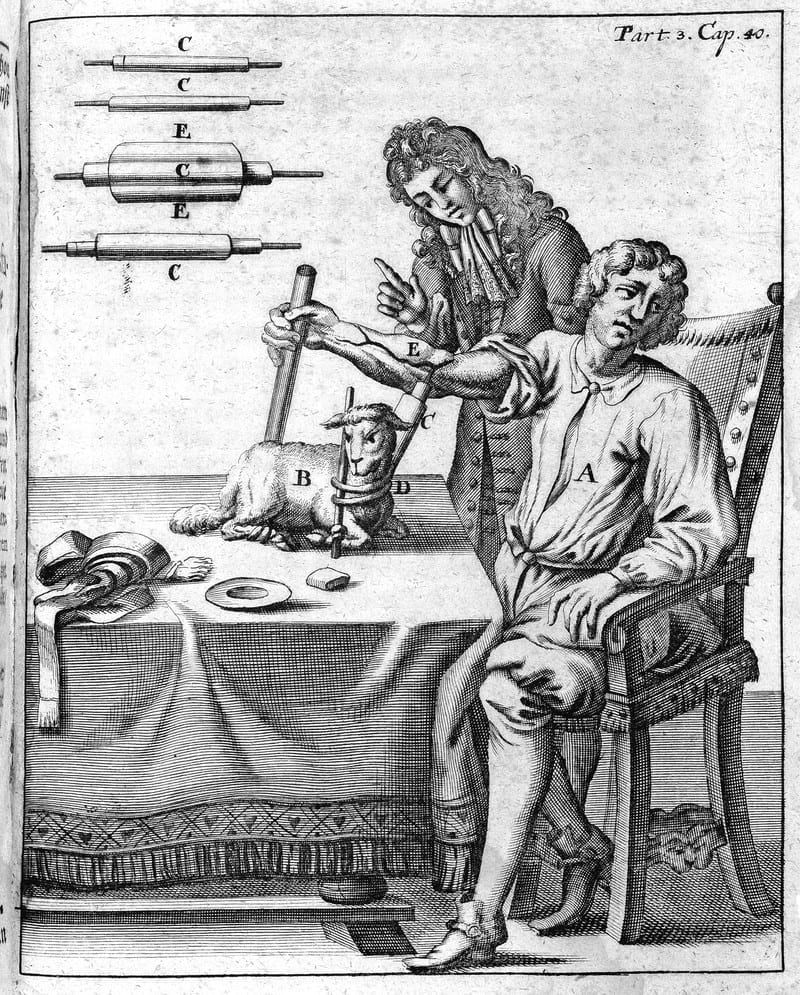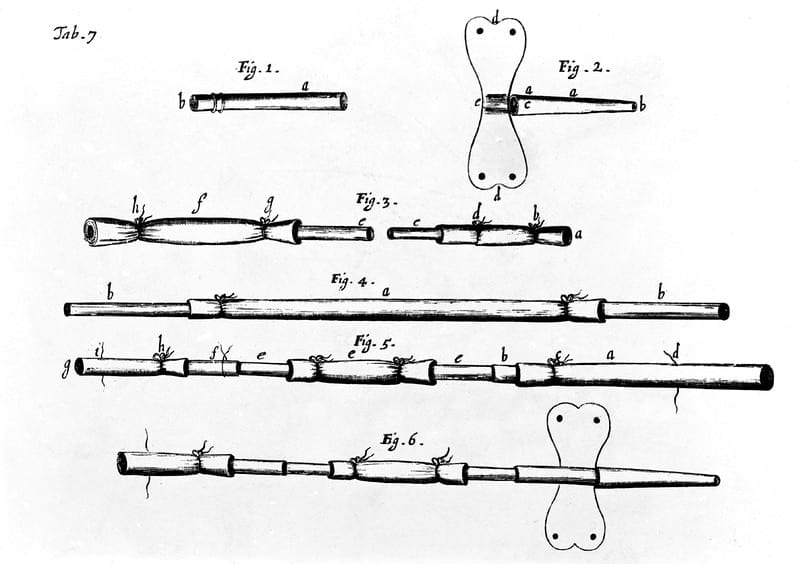Richard de Grijs
Sydney, Australia
Daniel Vuillermin
Beijing, China

“A young man of marvellous gifts who, when not yet sixteen years of age, advanced astronomy, gnomonics, statics, and mechanics by his distinguished discoveries, and from then on continues to advance these sciences. And truly he is the kind of man from whom I can shortly expect great things.” —William Oughtred1
Yet even Oughtred could not have foreseen the broad scope of the “great things” that were to happen. Scientific progress does not always proceed linearly. Medical history is replete with unexpected twists and turns—the discovery of nitrous oxide and the development of X-rays, insulin, and penicillin—with major advances occasionally originating from unlikely proponents.
Having displayed exceptional promise in astronomy from the age of thirteen,2 Oughtred’s “young man” was the celebrated architect Christopher Wren (1632–1723). Wren’s intellectual pursuits and the regular discussions with his close associates in Robert Boyle’s “invisible college” led to the founding of the Royal Society of London. He was appointed to the Savilian Chair of Astronomy at Oxford University when he had just turned twenty-eight.
Wren was an excellent example of the new possibilities of his time. Isaac Newton, never one to heap lavish praise on anyone, considered him one of the leading geometers of the day. Yet perhaps least known among Wren’s major achievements is his early work in medicine. In fact, the Royal Society’s charter of 1662 lists Wren as a “doctor in medicine,”3 despite a lack of evidence that he had received a medical degree.4
In Wren’s time the Renaissance had already reached British shores from its southern European origins and the critical thinking of the Scientific Revolution had taken center stage. New ideas were welcomed and inquisitive minds encouraged. Galileo’s invention of the telescope is perhaps the best known example to have triggered a step change in our understanding of the natural world, but so was William Harvey’s discovery of the continuous circulation of blood.
Galen’s teachings had suggested that blood was continuously produced in the liver, transported to the heart, and subsequently passed through arteries and veins to the tissues, where it was burned up.5 Therefore, it did not occur to the physicians of the day to pursue blood transfusions to either restore “diseased blood” or replace it following major trauma.
Practical therapeutic blood transfusions in humans required several intellectual leaps—starting with the idea of introducing fluids and drugs into an animal’s circulation, extending this to include blood as one’s agent, pursuing experimental work to verify its viability, to eventual therapeutic applications.6 It required an intellectual heavyweight of Wren’s stature to put these startling new ideas into practice and inject animals with different substances:
“By this Operation divers Creatures were immediately purg’d, vomited, intoxicated, kill’d, or reviv’d, according to the quality of the Liquor injected: Hence arose many new Experiments, and chiefly that of Transfusing Blood.”7
In 1656 Wren told a friend,
“The most considerable experiment I have made of late, is this; I injected wine and ale into the mass of blood of a living dog, by a vein, in good quantities, till I made him extremely drunk, but soon after he pissed it out . . . It will be too long to tell you the effect of opium, scammony, and other things which I have tried this way. I am in pursuit of further experiments . . . and what will give great light to the theory and practice of physick.”8
Wren’s early experiments established the baseline for the invention of intravenous therapy. Transfusion of blood between animals followed in 1659, eventually leading to blood transfusions between sheep and men,9 a practice that became fashionable in the 1660s. One of the first human experiments, allegedly using a minuscule amount of Crocus metallorum (antimony) injected by a foreign diplomat into the veins of a servant he was not too fond of, was cut short when the diplomat realized the effect he had caused; the servant apparently survived.10

Despite Wren’s early achievements, the French disputed his claim of priority, clamoring that Robert Desgabets had already suggested the practice a decade earlier. Meanwhile, the Italians loudly proclaimed that one of their own, Andreas Libavius, had already outlined a similar method in 1615. Indeed he had, but only to condemn and ridicule it as dangerous.11,12
Wren’s successful experiments prompted the physicians Richard Lower and Edmund King to undertake blood transfusion experiments for the Royal Society. In the mid-1660s they reported13 on two transfusions of arterial sheep’s blood to human subjects. Soon afterwards, the Parisian physician Jean-Baptiste Denys reported similar transfusion experiments as a remedy for psychiatric disorders.
Initially sheep and bovine animals were preferred blood donors. Human donors had not yet entered the equation. Animal experiments, particularly using young specimens, continued with reports that young blood transferred between dogs led to remarkable rejuvenation. It is likely that these were the effects of hormone transmission. Berry and Parker14 suggest that the use of sheep, in particular, may have had its origins in the Bible, where positive references to “the blood of lamb” and “sacrificial lambs” abound.
Intriguingly, half a world away, Chinese physicians were aware of blood circulation in the human body more than 1500 years before Harvey. At a meeting of the Royal Society in 1682, where the significance of the human pulse was discussed, Wren acknowledged that Chinese physicians were:
“. . . extremely curious about feeling the pulse of the patient, examining the beating thereof, not only in the wrist, but in various other parts of the body, . . .; and he was of the opinion that the ancients might know and make more use of the information of the pulse than our modern physicians of Europe; and that there might be more in Galen’s curiosity about the pulse than was generally understood.”15
Yet for Chinese physicians the sensations of the pulse were not to measure heart rate but rather to diagnose a patient’s flow of qi (氣)—or life force.16 Unschuld suggests17 that there may have been several schools of ancient Chinese medicine that emerged in the third and first centuries BCE, each proposing different theories of qi and blood circulation. One may have believed that qi flowed through the veins; another thought that only blood flowed; a third surmised that both qi and blood circulated through the same vessels; and a further school inferred that qi and blood flowed through separate arteries.
Classic Chinese medical texts, including the Inner Canon of the Yellow Emperor, confirm that ancient Chinese physicians linked the heart with the veins, given statements such as “the heart masters the vessels” and “blood belongs to the heart.”18 Importantly, there is no evidence that ancient Chinese physicians discovered that the heart was responsible for pumping blood through the circulatory system.19 This was, however, acknowledged well before Wren’s innovations by the British physician and historian John Floyer:
“Tho’ neither the Greeks nor the Chinese knew the true Fabrick of the Organs of the Pulse, nor their true action and uses, nor the Circulation of the Humours, and the causes of it; yet the Greeks discovered the Pulses of all Diseases and Humours, and Passions: And the Chinese founded their Art of Physic on the Pulse and its differences.”20
In the mid-nineteenth century, as Western colonial powers expanded into China, blood circulation was used as evidence of the superiority of their approach to medicine. According to the British medical missionary Benjamin Hobson, since medical students trained in Europe were able to dissect cadavers,
“. . . all Western physicians comprehend the mysteries of the organs and the blood vessels. Chinese who study medicine do not even have one single such [experience].”
Despite their understanding of the circulatory system, it took until the nineteenth century for recorded evidence of blood transfusion to emerge in the Far East. In 1819 a Japanese book in a Dutch translation—obtained through emerging trade networks—included figures by the German anatomist Lorenz Heister that showed early concepts of blood transfusion.21 The history of medicine thus reflects the history of international trade and knowledge transfer, although with a delay in the adoption of newly introduced techniques.
References
- Oughtred W 1652. Clavis Mathematicae. Oxford: Lichfield.
- Hutchison HF 1973. Sir Christopher Wren, 1632–1723. Hist. Today, 23, 229–238.
- Royal Society 1940. The Record of the Royal Society of London. 4th ed., Edinburgh: Morrison & Gibb, p. 229.
- Stimson D 1941. Christopher Wren, F.R.S., Sci. Monthly, 53, 360–367.
- Singer C & Underwood EA 1962. A short history of medicine. 2nd ed. Oxford: Clarendon Press, p. 65.
- Keynes G 1949. Blood transfusion. Bristol; Wright, p. 4.
- Sprat T 1667. History of the Royal Society of London. London: T. R. for J. Martyn & J. Allestry, p. 317.
- Wren C Jr 1715. Parentalia, or Memoirs of the Family of the Wrens … chiefly Sir Christopher Wren, … compiled by his son Christopher, now published by his grandson Stephen Wren, Esq. London, pp. 227–239.
- Ibid., p. 346.
- Ibid., pp. 227–239.
- Ibid.
- Berry FB & Parker HS 1962. Sir Christopher Wren: Compleat Philosopher. JAMA, 181, 117–120.
- Lower R 1666. The method observed in transfusing blood out of one live animal into another. Phil. Trans. R. Soc. Lond., 1, 353–358.
- Berry & Parker 1962. Op. cit.
- Gibson WC 1970. The Bio-Medical Pursuits of Christopher Wren. Med. Hist., 14, 331–341.
- Unschuld P 1985. Medicine in China: A History of Ideas. Los Angeles, CA: Univ. California Press, p. 75.
- Ibid.
- Ibid., p. 76.
- Ibid.
- Floyer, J 1707–1710. The Physician’s Pulse-Watch, pp. 339–340.
- Shimizu M & Mazda T 2009. Historical views of bloodletting and transfusion from the beginning to the present status in Japan. ISBT Sci. Ser., 4, 402–408.
RICHARD DE GRIJS, PhD, is a professor of astrophysics and Associate Dean (Global Engagement) at Macquarie University in Sydney, Australia. He has a keen interest in the history of science.
DANIEL VUILLERMIN, PhD, is a lecturer at the School of Health Humanities at Peking University, China, and section editor of the Palgrave Encyclopedia of Health Humanities.
Submitted for the 2019–2020 Blood Writing Contest & Highlighted in Frontispiece Volume 12, Issue 2 – Spring 2020 and Volume 14, Issue 4 – Fall 2022

Leave a Reply